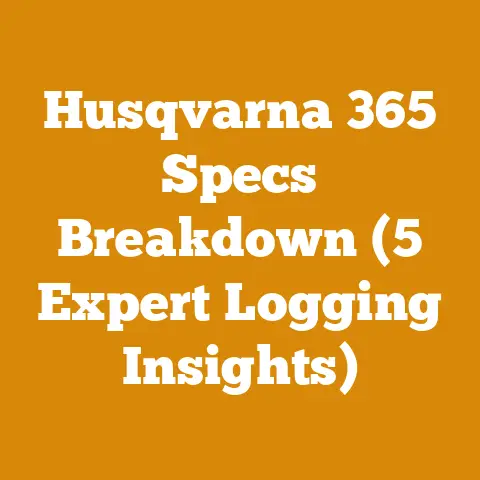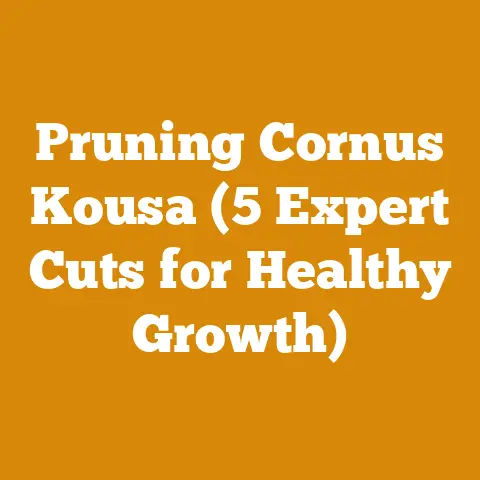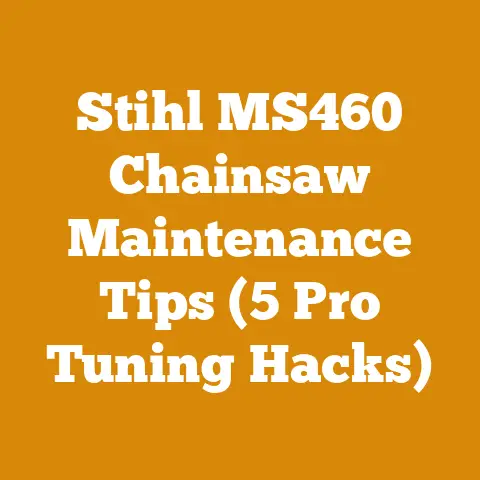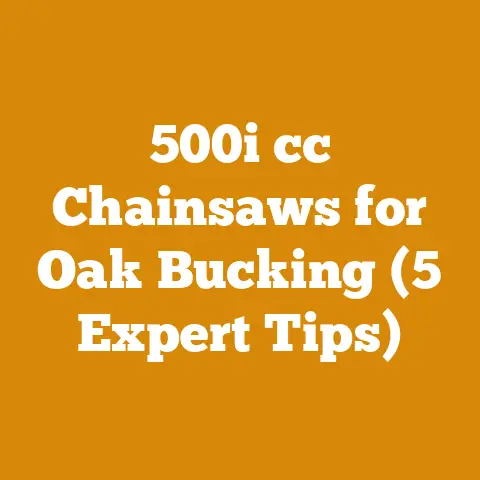Tree Planting Spade Tips (Pro Tools for Efficient Wood Planting)
Tree Planting Spade Tips (Pro Tools for Efficient Wood Planting)
Are you wrestling with the challenge of efficient tree planting? It’s a problem I’ve faced countless times. Whether you’re a seasoned forester replanting after a harvest or a weekend warrior trying to establish a small woodlot, the right tools can make all the difference. The answer, more often than not, lies in understanding and utilizing the best tree planting spades.
Understanding the Tree Planting Spade: More Than Just a Shovel
The tree planting spade, sometimes called a dibble bar or planting bar, is a specialized tool designed to create the perfect hole for saplings with minimal soil disturbance. Unlike a regular shovel, it’s engineered for speed, precision, and ergonomics, crucial for large-scale planting operations.
Why Choose a Tree Planting Spade?
- Efficiency: A well-designed spade allows you to plant hundreds of trees per day with less fatigue compared to using shovels or augers.
- Survival Rate: The tight-fitting hole created by a spade ensures good root-to-soil contact, vital for seedling survival.
- Ergonomics: Many models are designed with features to reduce back strain and improve user comfort.
Types of Tree Planting Spades and Their Applications
The world of tree planting spades isn’t a one-size-fits-all situation. Different soil types, terrain, and planting stock require specific spade designs.
The Standard Planting Spade
This is your bread-and-butter spade. It typically features a long, narrow blade with a pointed or slightly rounded tip. It’s ideal for planting in relatively loose soil with minimal rocks or debris.
- Cost: $50 – $150
- Pros: Versatile, relatively inexpensive, good for general planting.
- Cons: Not suitable for rocky or compacted soils, can be tiring for extended use.
The Hoedad
The hoedad is a heavy-duty tool designed for planting in tough conditions, such as rocky soils or steep slopes. It features a heavier blade and a more robust handle. The action is more of a chopping motion than a digging one. This is a common choice for reforestation in challenging landscapes.
- Cost: $80 – $200
- Pros: Excellent for rocky and compacted soils, durable, good for steep slopes.
- Cons: Heavier than standard spades, requires more physical effort, can be less precise.
The Augur-Type Spade
These spades feature a spiral or auger-shaped blade that bores into the soil. They are particularly useful for planting in dry or compacted soils where creating a hole with a standard spade is difficult.
- Cost: $100 – $300
- Pros: Effective in dry and compacted soils, creates a consistent hole size.
- Cons: More expensive than standard spades, can be difficult to use in rocky soils, requires more maintenance.
Specialty Spades
There are also specialty spades designed for specific planting tasks, such as planting containerized seedlings or planting in heavy clay soils. These spades often feature unique blade shapes or ergonomic designs.
- Cost: $75 – $350+ (depending on the specialty)
- Pros: Optimized for specific planting tasks, can significantly improve efficiency and survival rates in certain conditions.
- Cons: More expensive, less versatile than standard spades, may require specialized training to use effectively.
Cost Breakdown: Investing in the Right Tool
The cost of a tree planting spade is a significant factor, but it’s essential to consider the long-term benefits. A high-quality spade will last longer, improve planting efficiency, and ultimately contribute to higher seedling survival rates.
Initial Purchase Price
As mentioned earlier, the initial cost of a tree planting spade can range from $50 to $350 or more, depending on the type and quality.
- Budget Spades ($50-$100): These are typically made with lighter materials and may not be as durable. They are suitable for small-scale planting projects or for users who only plant occasionally.
- Mid-Range Spades ($100-$200): These spades offer a good balance of quality and price. They are typically made with durable materials and feature ergonomic designs. This is the sweet spot for most users.
- High-End Spades ($200-$350+): These spades are made with the highest quality materials and feature advanced ergonomic designs. They are designed for professional use and can withstand heavy use in demanding conditions.
Maintenance Costs
Like any tool, a tree planting spade requires regular maintenance to keep it in good working order.
- Sharpening: The blade of the spade should be sharpened regularly to ensure efficient cutting. I recommend sharpening your spade after every 40-80 hours of use, depending on soil conditions. A sharpening stone or file costs between $10 and $30.
- Cleaning: The spade should be cleaned after each use to remove soil and debris. This will prevent rust and corrosion. A wire brush and some WD-40 should do the trick, costing you less than $10.
- Handle Replacement: The handle of the spade may need to be replaced if it becomes damaged or worn. A replacement handle typically costs between $20 and $50.
- Welding Repairs: If you are using Hoedads in rocky areas, you may need to weld them from time to time.
Replacement Costs
Even with proper maintenance, a tree planting spade will eventually need to be replaced. The lifespan of a spade depends on the quality of the materials and the intensity of use.
- Budget Spades: May last 1-3 years with regular use.
- Mid-Range Spades: May last 3-5 years with regular use.
- High-End Spades: May last 5-10 years or more with proper care.
Labor Costs: Time is Money
The cost of labor is a significant factor in any tree planting project. Using the right spade can significantly reduce labor costs by improving planting efficiency.
Planting Rate
The number of trees that can be planted per day depends on several factors, including the type of spade, the soil conditions, the terrain, and the skill of the planter.
- Using a Standard Spade: A skilled planter can typically plant 500-800 trees per day.
- Using a Hoedad: A skilled planter can typically plant 300-600 trees per day.
- Using an Auger-Type Spade: A skilled planter can typically plant 400-700 trees per day.
Wage Rates
Wage rates for tree planters vary depending on location, experience, and the type of work being performed. According to the US Bureau of Labor Statistics, the median hourly wage for forest and conservation workers in May 2022 was $17.74. However, wage rates can range from $12 to $30 or more per hour. I have seen tree planting contractors in remote locations pay more than $30/hour to attract experienced planters.
Calculating Labor Costs
To calculate the labor cost of a tree planting project, you need to estimate the number of trees that need to be planted, the planting rate, and the wage rate.
-
Example: Let’s say you need to plant 10,000 trees and you estimate that a planter can plant 600 trees per day using a standard spade. If the wage rate is $20 per hour, the labor cost would be calculated as follows:
- Days required to plant 10,000 trees: 10,000 trees / 600 trees/day = 16.67 days
- Total labor hours: 16.67 days * 8 hours/day = 133.33 hours
- Total labor cost: 133.33 hours * $20/hour = $2,666.60
Seedling Costs: The Foundation of Your Forest
Seedling costs are another significant expense in any tree planting project. The cost of seedlings varies depending on the species, size, and quantity.
Bare-Root Seedlings
Bare-root seedlings are seedlings that have been grown in a nursery bed and then lifted from the soil without any soil around their roots. They are typically less expensive than containerized seedlings.
- Cost: $0.50 – $2.00 per seedling
Containerized Seedlings
Containerized seedlings are seedlings that have been grown in individual containers. They are typically more expensive than bare-root seedlings but have a higher survival rate.
- Cost: $1.00 – $5.00 per seedling
Factors Affecting Seedling Costs
- Species: Some tree species are more expensive to grow than others. For example, hardwood species like oak and maple are typically more expensive than softwood species like pine and fir.
- Size: Larger seedlings are typically more expensive than smaller seedlings.
- Quantity: Seedling nurseries often offer discounts for large orders.
- Location: Seedling costs can vary depending on the location of the nursery.
- Genetics: Seedlings with improved genetics, selected for growth rate, disease resistance, or other desirable traits, will command a premium.
Calculating Seedling Costs
To calculate the seedling cost of a tree planting project, you need to know the number of trees that need to be planted and the cost per seedling.
-
Example: Let’s say you need to plant 10,000 trees and the cost per seedling is $1.50. The seedling cost would be calculated as follows:
- Total seedling cost: 10,000 trees * $1.50/seedling = $15,000
Site Preparation Costs: Preparing the Ground
Site preparation is the process of preparing the planting site for seedlings. This can involve clearing vegetation, removing debris, and improving soil conditions.
Methods of Site Preparation
- Mechanical Clearing: This involves using heavy equipment, such as bulldozers and excavators, to clear vegetation and remove debris. This is the most expensive method of site preparation but is also the most effective for large-scale projects.
- Chemical Clearing: This involves using herbicides to kill unwanted vegetation. This is a less expensive method of site preparation than mechanical clearing but can have negative environmental impacts.
- Burning: This involves burning off unwanted vegetation. This is a relatively inexpensive method of site preparation but can be dangerous and requires careful planning and execution.
- Manual Clearing: This involves using hand tools, such as chainsaws and brush cutters, to clear vegetation. This is the least expensive method of site preparation but is also the most labor-intensive.
Cost of Site Preparation
The cost of site preparation varies depending on the method used, the size of the area being prepared, and the type of vegetation being cleared.
- Mechanical Clearing: $500 – $2,000 per acre
- Chemical Clearing: $100 – $500 per acre
- Burning: $50 – $200 per acre
- Manual Clearing: $200 – $1,000 per acre
Factors Affecting Site Preparation Costs
- Vegetation Type: The type of vegetation being cleared will affect the cost of site preparation. For example, clearing dense brush will be more expensive than clearing grass.
- Terrain: The terrain of the planting site will also affect the cost of site preparation. For example, clearing steep slopes will be more expensive than clearing flat ground.
- Accessibility: The accessibility of the planting site will also affect the cost of site preparation. For example, clearing a site that is difficult to access will be more expensive than clearing a site that is easily accessible.
- Regulations: Some areas have regulations that restrict the type of site preparation that can be used. For example, some areas prohibit the use of herbicides.
Calculating Site Preparation Costs
To calculate the site preparation cost of a tree planting project, you need to know the size of the area being prepared and the cost per acre.
-
Example: Let’s say you need to prepare 10 acres of land for planting and the cost per acre for mechanical clearing is $1,000. The site preparation cost would be calculated as follows:
- Total site preparation cost: 10 acres * $1,000/acre = $10,000
Other Costs to Consider
In addition to the costs mentioned above, there are several other costs to consider when budgeting for a tree planting project.
Transportation Costs
Transportation costs can include the cost of transporting seedlings to the planting site, the cost of transporting workers to the planting site, and the cost of transporting equipment to the planting site.
- Seedling Transportation: The cost of transporting seedlings depends on the distance between the nursery and the planting site, the number of seedlings being transported, and the mode of transportation. A rough estimate is $0.10 – $0.50 per seedling for transportation.
- Worker Transportation: The cost of transporting workers depends on the distance between the workers’ homes and the planting site, the number of workers being transported, and the mode of transportation. Consider fuel costs, vehicle maintenance, and potentially vehicle rental.
- Equipment Transportation: The cost of transporting equipment depends on the type of equipment being transported, the distance between the equipment storage location and the planting site, and the mode of transportation.
Supervision Costs
Supervision costs can include the cost of hiring a supervisor to oversee the planting project. A supervisor’s salary can range from $40,000 to $80,000 per year, or $25-$50 per hour.
Insurance Costs
Insurance costs can include the cost of workers’ compensation insurance and liability insurance. Workers’ compensation insurance rates vary depending on the state and the type of work being performed. Liability insurance rates vary depending on the size of the project and the amount of coverage needed.
Permitting Costs
Permitting costs can include the cost of obtaining permits from local, state, and federal agencies. The cost of permits varies depending on the location of the project and the type of work being performed.
Miscellaneous Costs
Miscellaneous costs can include the cost of tools, supplies, and other expenses that are not included in the categories above. This might include flagging tape, insect repellent, first aid supplies, and water bottles.
Cost Optimization Strategies: Saving Money Without Cutting Corners
There are several strategies you can use to optimize the cost of a tree planting project without sacrificing quality or efficiency.
Plan Ahead
Planning ahead is essential for cost optimization. This includes developing a detailed budget, securing funding, and ordering seedlings well in advance of the planting date.
Negotiate Prices
Don’t be afraid to negotiate prices with seedling nurseries, equipment rental companies, and other vendors. You may be able to get a discount by ordering in bulk or by paying in cash.
Use Volunteers
Consider using volunteers to help with the planting project. This can significantly reduce labor costs.
Choose the Right Tools
Choosing the right tools is essential for maximizing efficiency and minimizing costs. Invest in high-quality tree planting spades that are appropriate for the soil conditions and terrain.
Implement Erosion Control
Implementing erosion control measures can help to prevent soil loss and protect water quality. This can save you money in the long run by reducing the need for costly repairs and remediation.
Monitor Progress
Regularly monitor the progress of the planting project to identify and address any problems early on. This can help to prevent costly delays and overruns.
Consider Government Subsidies
Many governments offer subsidies and tax breaks for tree planting projects. Research the available incentives in your area and take advantage of them. In the US, the NRCS (Natural Resources Conservation Service) offers funding and technical assistance to landowners for conservation practices, including tree planting.
Case Studies: Real-World Examples of Cost Management
To illustrate the importance of cost management in tree planting projects, let’s look at a few case studies.
Case Study 1: Small-Scale Reforestation Project
A private landowner in Oregon wanted to reforest 10 acres of land that had been recently harvested. The landowner had a limited budget and wanted to minimize costs.
- Solution: The landowner chose to use bare-root seedlings, which were less expensive than containerized seedlings. They also used volunteers to help with the planting, which significantly reduced labor costs. They opted for manual site preparation to keep costs down, focusing on clearing only the immediate planting spots.
- Results: The landowner was able to successfully reforest the 10 acres of land at a cost of $5,000, which was significantly less than the initial budget estimate of $8,000.
Case Study 2: Large-Scale Reforestation Project
A timber company in British Columbia wanted to reforest 1,000 acres of land that had been recently burned by a wildfire. The timber company had a larger budget but wanted to maximize efficiency and minimize environmental impacts.
- Solution: The timber company chose to use containerized seedlings, which had a higher survival rate than bare-root seedlings. They also used mechanical site preparation to clear the land quickly and efficiently. They implemented erosion control measures to protect water quality.
- Results: The timber company was able to successfully reforest the 1,000 acres of land at a cost of $1.5 million, which was within the initial budget estimate. The project also resulted in significant environmental benefits, including improved water quality and increased carbon sequestration.
Practical Examples
Let’s break down some practical examples to solidify your understanding.
- Example 1: Choosing the Right Spade for Rocky Soil: You’re planting on a hillside in Montana with rocky soil. A standard planting spade will likely bend or break. The Hoedad is the clear winner here. Although it requires more effort, it will get the job done and save you the cost of replacing a broken spade. This upfront investment in a more robust tool is a cost-saving measure in disguise.
- Example 2: Calculating Seedling Spacing for Optimal Growth: You’re planting pine trees and want to determine the optimal spacing. A general rule of thumb is 8-10 feet between trees. This translates to roughly 435 to 680 trees per acre. Ordering the correct number of seedlings avoids waste and ensures you’re not overspending on more trees than you need. If your seedlings cost $1.50 each, the difference between 435 and 680 trees is a cost swing of $367.50 per acre.
Industry Benchmarks and Statistical Data
To provide context for the cost figures presented in this article, let’s look at some industry benchmarks and statistical data.
- Average Cost of Reforestation: According to the US Forest Service, the average cost of reforestation in the United States ranges from $200 to $1,000 per acre, depending on the region, the species being planted, and the site preparation methods used.
- Average Seedling Survival Rate: The average seedling survival rate varies depending on the species, the planting methods used, and the site conditions. A well-managed tree planting project should aim for a survival rate of 80% or higher. Data from the US Forest Service indicates that survival rates can range from 60% to 95%, highlighting the importance of proper planning and execution.
- Global Timber Prices: Global timber prices fluctuate depending on supply and demand. According to the FAO (Food and Agriculture Organization of the United Nations), global timber prices have been increasing in recent years due to increased demand from developing countries. This makes efficient tree planting even more important for ensuring a sustainable timber supply.
Technical Explanations and Formulas
For those interested in a more technical understanding of tree planting costs, let’s look at some relevant calculations and formulas.
-
Calculating Planting Density: To calculate the planting density, you can use the following formula:
- Planting Density (trees/acre) = 43,560 / (Spacing (ft) * Spacing (ft))
- Estimating Drying Time: If you are planting seedlings that have been stored for a period of time, it’s important to estimate the drying time. The drying time depends on the moisture content of the seedlings and the environmental conditions. A general rule of thumb is that seedlings should be planted within 24 hours of being removed from storage.
Actionable Takeaways and Next Steps
Planning a tree planting project can feel daunting, but with careful planning and the right tools, it can be a rewarding experience. Here are some actionable takeaways and next steps:
- Assess your site: Determine the soil type, terrain, and vegetation type.
- Choose the right spade: Select a spade that is appropriate for the site conditions.
- Develop a detailed budget: Include all costs, such as seedlings, labor, site preparation, and transportation.
- Secure funding: Explore government subsidies and other funding opportunities.
- Order seedlings well in advance: Ensure that you have enough seedlings of the desired species and size.
- Implement erosion control measures: Protect water quality and prevent soil loss.
- Monitor progress: Regularly monitor the planting project and address any problems early on.
- Consult with experts: Seek advice from foresters, arborists, or other tree planting professionals.
Conclusion: Planting the Seeds of Success
Tree planting is an investment in the future. By carefully planning and managing your tree planting project, you can ensure that it is both successful and cost-effective. Remember that the right tools, like a well-chosen tree planting spade, are not just expenses, but investments in efficiency, survival rates, and ultimately, the health and longevity of your forest. It’s about planting the seeds of success, both literally and figuratively.






